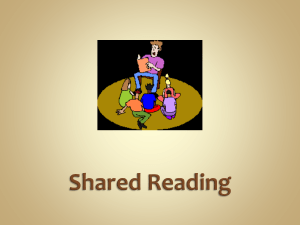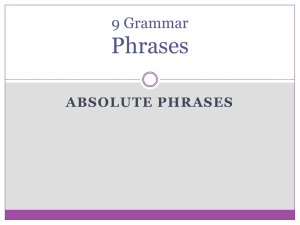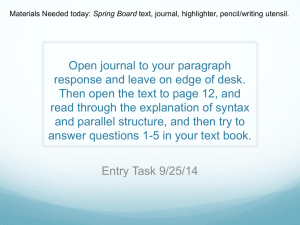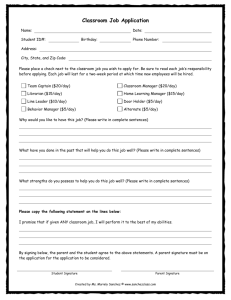Embedded Readings (Laurie Clarcq)
advertisement
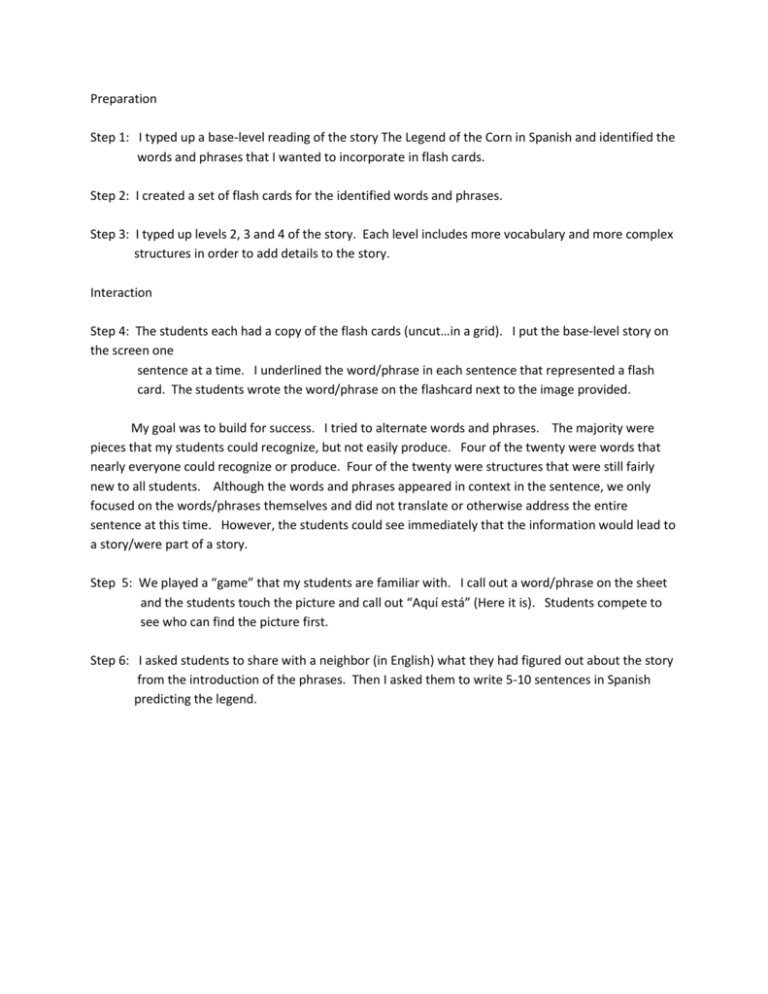
Preparation Step 1: I typed up a base-level reading of the story The Legend of the Corn in Spanish and identified the words and phrases that I wanted to incorporate in flash cards. Step 2: I created a set of flash cards for the identified words and phrases. Step 3: I typed up levels 2, 3 and 4 of the story. Each level includes more vocabulary and more complex structures in order to add details to the story. Interaction Step 4: The students each had a copy of the flash cards (uncut…in a grid). I put the base-level story on the screen one sentence at a time. I underlined the word/phrase in each sentence that represented a flash card. The students wrote the word/phrase on the flashcard next to the image provided. My goal was to build for success. I tried to alternate words and phrases. The majority were pieces that my students could recognize, but not easily produce. Four of the twenty were words that nearly everyone could recognize or produce. Four of the twenty were structures that were still fairly new to all students. Although the words and phrases appeared in context in the sentence, we only focused on the words/phrases themselves and did not translate or otherwise address the entire sentence at this time. However, the students could see immediately that the information would lead to a story/were part of a story. Step 5: We played a “game” that my students are familiar with. I call out a word/phrase on the sheet and the students touch the picture and call out “Aquí está” (Here it is). Students compete to see who can find the picture first. Step 6: I asked students to share with a neighbor (in English) what they had figured out about the story from the introduction of the phrases. Then I asked them to write 5-10 sentences in Spanish predicting the legend. Day Two : Thanks to Michele Well sunshine was the competition today :o) but I was still pleased with how smoothly the class went. Here is how we worked it: Preparation: Step 7: I used the flash card graphics (copy and paste whoo hoo!!) to put together a PowerPoint (very basic!!! I’m getting good at those ) of the base-level reading…one slide per sentence. When I say simple, I mean simple!! The sentence in the story is The corn was behind the mountains. The slide had a piece of corn and a mountain. I right clicked on the corn and clicked Move to Back so it looked like it was peeking out from behind the mountain. That was it!!! There were no words/phrases/sentences on the slides. There were 20 sentences so I made 20 slides. Because the images were right from the flashcard document it took me very little time. I then added a few additional pictures to the PP for questions. Example: in the legend, Quetzalcoatl is “on the road” to the other side of the mountains and I had used a clip art pic of a modern road for the flashcards. In the PP I added several pics of roads (thank you Google images! ) including one of a winding stone path in the mountains that eventually became the road in the story…but first we looked at and rejected several roads that wouldn’t have been the road in the story ( a city street, a highway, a toy car set etc.) Step 8: I printed out copies of the base-level story. (20 sentences with a few clip art flashcard graphics thrown in next to the less-familiar phrases.) Also, copies of Level 2 of the story ( The same 20 sentences without the clip art, 5 additional sentences and 5 of the original sentences had an added detail or a word change…..example “brought” instead of “carried” …therefore 15 sentences remained exactly the same.) Interaction: Step 9 : We did a very quick round of “Está aquí” (non-competitive) as a warm-up and then they read their story predictions from yesterday to a partner while I went around the room eavesdropping. :o) Step 10: They kept the labeled flash card grid on their desks while I told the story using the PP. I was able to do a lot of interesting circling because I could compare the legend with their predictions from the day before. At any point I could also pause and ask a new prediction question….will he turn into a person or an ant? Will he carry the seed on his back or in his mouth? It got very funny because somehow Quetzalcoatl went from being the most powerful god to the Chuck Norris of Aztec gods. The mental image of Chuck Norris’ face on the body of a plumed serpent turned ant carrying corn in his mouth was priceless. (Don’t worry, it didn’t get disrespectful, but it did make for a funny moment!!) Step 11: I passed out the base-level reading . I read it out loud SLOWLY while they followed by underlining as I read the words. I paused at the end of each sentence so that they could picture that sentence in their heads. I told them to picture the PP, or the flashcards, or their own “movie clip”. If they couldn’t form an image, I asked them to circle that sentence or part of the sentence. (lots of smiles when Q turned into an ant…guess the CN image was still stuck in their heads lol) At the end they checked with a neighbor on the meaning of any circled items. (there were very few whoo hooo!) Step 12: I passed out the Level 2 reading and asked them to read it to themselves, again picturing the story as they read. I warned them that there would be some new pieces. Then I asked them to work in pairs or trios to find the differences between the base-level and Level 2 readings and underline them on the Level 2 reading. And then we ran out of time!!!! I have so many things I could do tomorrow ….I’m still thinking about it…… What they don’t know is that next week they’ll be working on adapting the Aztec Legend of the Corn to the Marcus Whitman Legend of the Corn. (Did I tell you that we are surrounded by cornfields? ) :o)


